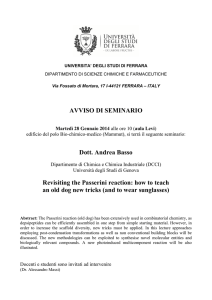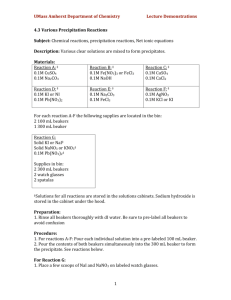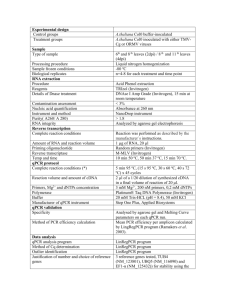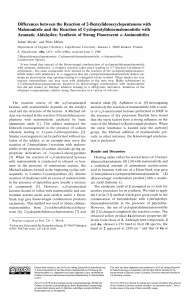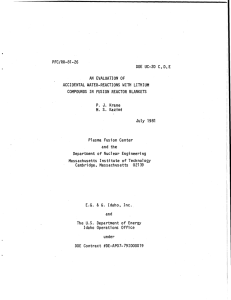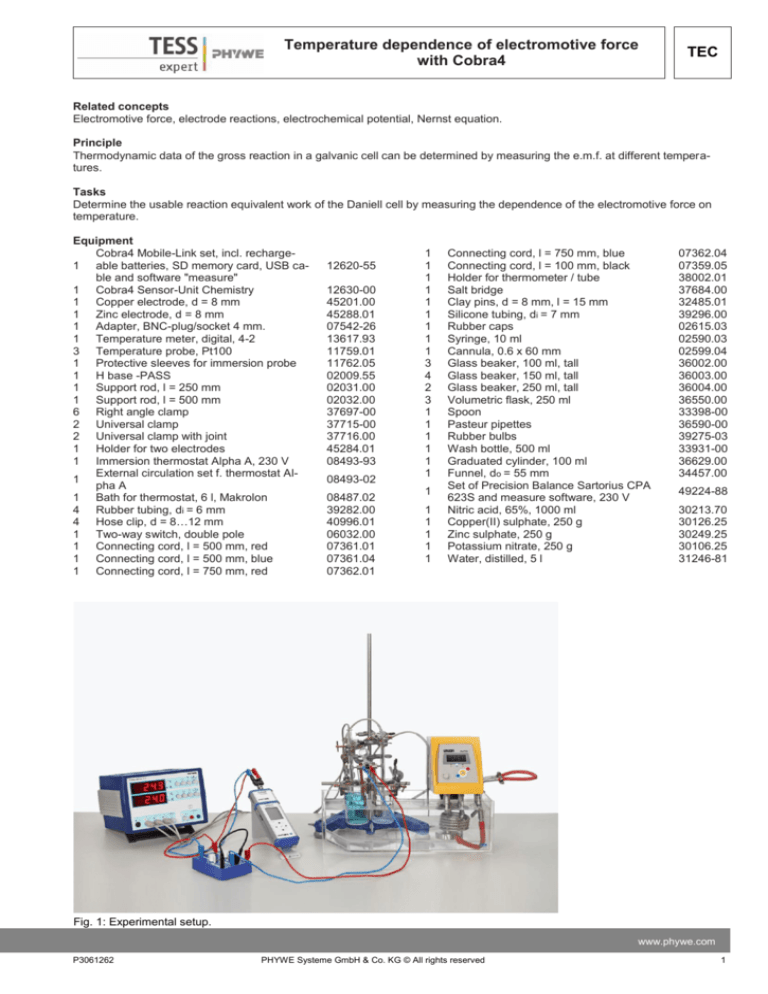
Temperature dependence of electromotive force
with Cobra4
TEC
Related concepts
Electromotive force, electrode reactions, electrochemical potential, Nernst equation.
Principle
Thermodynamic data of the gross reaction in a galvanic cell can be determined by measuring the e.m.f. at different temperatures.
Tasks
Determine the usable reaction equivalent work of the Daniell cell by measuring the dependence of the electromotive force on
temperature.
Equipment
Cobra4 Mobile-Link set, incl. recharge1 able batteries, SD memory card, USB cable and software "measure"
1 Cobra4 Sensor-Unit Chemistry
1 Copper electrode, d = 8 mm
1 Zinc electrode, d = 8 mm
1 Adapter, BNC-plug/socket 4 mm.
1 Temperature meter, digital, 4-2
3 Temperature probe, Pt100
1 Protective sleeves for immersion probe
1 H base -PASS
1 Support rod, l = 250 mm
1 Support rod, l = 500 mm
6 Right angle clamp
2 Universal clamp
2 Universal clamp with joint
1 Holder for two electrodes
1 Immersion thermostat Alpha A, 230 V
External circulation set f. thermostat Al1
pha A
1 Bath for thermostat, 6 l, Makrolon
4 Rubber tubing, di = 6 mm
4 Hose clip, d = 8…12 mm
1 Two-way switch, double pole
1 Connecting cord, l = 500 mm, red
1 Connecting cord, l = 500 mm, blue
1 Connecting cord, l = 750 mm, red
12620-55
12630-00
45201.00
45288.01
07542-26
13617.93
11759.01
11762.05
02009.55
02031.00
02032.00
37697-00
37715-00
37716.00
45284.01
08493-93
08493-02
08487.02
39282.00
40996.01
06032.00
07361.01
07361.04
07362.01
1
1
1
1
1
1
1
1
1
3
4
2
3
1
1
1
1
1
1
1
1
1
1
1
1
Connecting cord, l = 750 mm, blue
Connecting cord, l = 100 mm, black
Holder for thermometer / tube
Salt bridge
Clay pins, d = 8 mm, l = 15 mm
Silicone tubing, di = 7 mm
Rubber caps
Syringe, 10 ml
Cannula, 0.6 x 60 mm
Glass beaker, 100 ml, tall
Glass beaker, 150 ml, tall
Glass beaker, 250 ml, tall
Volumetric flask, 250 ml
Spoon
Pasteur pipettes
Rubber bulbs
Wash bottle, 500 ml
Graduated cylinder, 100 ml
Funnel, do = 55 mm
Set of Precision Balance Sartorius CPA
623S and measure software, 230 V
Nitric acid, 65%, 1000 ml
Copper(II) sulphate, 250 g
Zinc sulphate, 250 g
Potassium nitrate, 250 g
Water, distilled, 5 l
07362.04
07359.05
38002.01
37684.00
32485.01
39296.00
02615.03
02590.03
02599.04
36002.00
36003.00
36004.00
36550.00
33398-00
36590-00
39275-03
33931-00
36629.00
34457.00
49224-88
30213.70
30126.25
30249.25
30106.25
31246-81
Fig. 1: Experimental setup.
www.phywe.com
P3061262
PHYWE Systeme GmbH & Co. KG © All rights reserved
1
TEC
Temperature dependence of electromotive force
with Cobra4
Setup and procedure
Set up the experiment as shown in Fig. 1.
Prepare the solutions required for the experiment as follows:
–
1 molar CuSO4 solution: Weigh 62.420 g of copper(II) sulphate (CuSO4•5H2O) into a 250 ml volumetric flask, dissolve it in
distilled water, and make up to the mark with distilled water.
–
1 molar ZnSO4 solution: Weigh 71.8920 g of zinc sulphate (ZnSO4•7H2O) into a 250 ml volumetric flask, dissolve it in
distilled water, and make up to the mark with distilled water.
–
1 molar KNO3 solution: Weigh 25.276 g of potassium nitrate into a 250 ml volumetric flask, dissolve it in distilled water,
and make up to the mark with distilled water.
–
Saturated KNO3 solution: Weigh 20 g of potassium nitrate into a 150 ml beaker, add 50 ml of distilled water and stir for
some minutes at room temperature. Some potassium nitrate must remain on the bottom of the beaker in the solid state. If
this is not the case, additional potassium nitrate must be added. When the undissolved potassium nitrate has settled, decant the saturated solution into a second beaker.
Soak the clay pins in saturated potassium nitrate solution overnight.
Place the two half-cells (150 ml beakers) together in the bath of the immersion thermostat. Fill one beaker with 1 molar copper
sulphate solution and the other with 1 molar zinc sulphate solution. The level of the liquids in the beakers should be equal and
not higher than the surrounding water in the bath of the thermostat. Use a syringe with a cannula to carefully fill the salt bridge
with 1 molar potassium nitrate solution. Remove air bubbles by tapping at the arms of the salt bridge. Seal each arm of the salt
bridge with a soaked clay pin which is held in place by a short length (20 mm) of silicone tubing. Replace the cap. For every
new series of measurement a new pair of clay pins must be used because electrode reactions are extremely sensitive to impurities. Immerse the salt bridge in the two beakers to connect both solutions.
2
PHYWE Systeme GmbH & Co. KG © All rights reserved
P3061262
Temperature dependence of electromotive force
with Cobra4
TEC
Clean the copper and zinc electrodes by dipping them into a 250 ml glass beaker filled with 65 % nitric acid solution. After
cauterising, rinse the electrodes with distilled water and immediately afterwards put them in the corresponding half-cells.
Connect the electrodes to the pH-meter via the two-way switch as shown in Fig. 1 and Fig. 3. The high impedance of the
pHmeter prevents a flow of current through the cell during measurement. Place the temperature probes in the half-cells in protective
tubes filled with a few drops of water, and connect all three temperature probes to the temperature meter. Switch the pH-meter
to the mV measuring mode. Start the series of measurements at 20°C, and warm the water bath in steps of 5 degrees until a
temperature of 45°C is reached. Between the measurements, disconnect the cell from the pH-meter and short-circuit it by
means of the two-way switch (see Fig. 3).
Theory and evaluation
The electromotive force is the potential difference of the single potentials of two half-cells in a galvanic cell. From measurements
of the pressure and temperature dependence of the e.m.f., conclusions can be drawn on the thermodynamics of the cell reaction. One precondition is that the reaction must be isothermally and isobarically reversible. In this case, the reaction in the galvanic cell is connected with a change of the free enthalpy which is directly available as electric work in the form of an external
flow of current. It can be expressed as
where
G
Wel
zr
E
F
Free enthalpy
Electric work
Reaction charge number
Electromotive force e.m.f.
Faraday’s constant (= 96490 As · mol-1)
We can use the Gibbs-Helmholtz equation to calculate the temperature dependence of the e.m.f. at constant pressure:
H
T
Reaction enthalpy
Temperature
Using equation (1) and (2), we obtain:
We thus have a method to determine the reaction enthalpy. This method is more exact than calorimetric methods. The difference between the free enthalpy and the reaction enthalpy is called Peltier heat and is equal to the heat tone of the reversibly
proceeding cell reaction.
Data and results
For the Daniell cell:
and at 298 K, an e.m.f. of 1.099 V was determined. The value of the temperature coefficient E/T obtained from the plot of
-4
-1
e.m.f. / temperature (Fig. 4) is 3.69 · 10 V K .
We can obtain the free reaction enthalpy from equation (4):
www.phywe.com
P3061262
PHYWE Systeme GmbH & Co. KG © All rights reserved
3
TEC
H
Temperature dependence of electromotive force
with Cobra4
-1
-4
-1
= -2 · 96490 As · mol (1.099 V + 298 K · 3.69 · 10 V K )
-1
= -212.41 kJ · mol
and the available reaction work from (1):
G = -2 · 96490 As · mol · 1.099 V = -212.08 kJ · mol .
-1
-1
Lit. values:
-1
H = -234.9 kJ · mol
-1
G = -211 kJ · mol
The difference between the reaction enthalpy and the useful work of the reaction H- G is given up to the surroundings, the
remaining amount of energy is converted to electrical energy.
4
PHYWE Systeme GmbH & Co. KG © All rights reserved
P3061262

